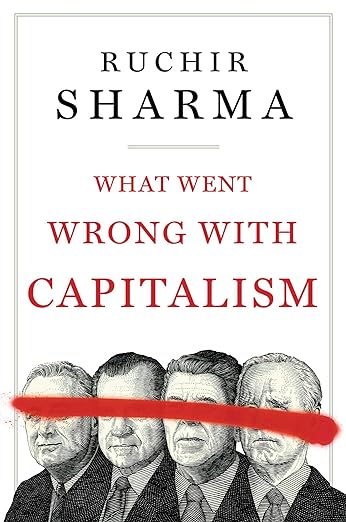
- Book Review of What Went Wrong with Capitalism? by Ruchir Sharma.
Capitalism has a “Pretty Pig” problem. The reference is to a state fair livestock contest, where there is a judging of the beauty of adult swine. There are only two entrants, because adult swine just aren’t pretty. The first pig is brought out, and the judges are horrified, because it’s ugly. The judges give the “Pretty Pig” award to the second pig, sight unseen.
Much of the political support for state intervention in, or outright replacement of, market processes is based on the same kind of shallow logic. Markets have “failures,” are sometimes chaotic, and seem to exacerbate inequalities. The problem is that that second ugly pig, the state, is never subjected to the same scrutiny. In fact, state “failures” are often attributed to problems with the market. Recently, price controls and restrictions on new housing starts have driven up the costs of homes and apartments. But instead of blaming misguided state policy, many commenters blame “greed” in the marketplace, advocating for even more state intervention.
To be fair, capitalism does have genuine problems. The focus on “market perfection” by some advocates has cost classical liberals a lot of credibility. We should all be “comparativists,” meaning that markets as they are should be compared to state regulations as they are.
My Duke colleague Richard Salsman and I have tried to make some honest comparisons along these lines. I have argued that capitalism has an inherent, and quite dangerous, tendency toward “cronyism.” The pursuit of profit is limited by law, not morality, in a system where competition for managers will select for those who are willing to seek the favor of government, in the form of subsidies, entry barriers, and trade protection. Richard Salsman has pointed out that pressures for cronyism may well originate with state actors, for whom the “selling” of rents can be very beneficial.
Regardless of the direction of causation—whether corporations seek rents, and turn away from making better, cheaper products, or whether politicians sell rents as a way of accumulating power and influence—capitalism in a democracy is precarious. There must be rules, preferably at the constitutional level, that limit the ability of government to pick winners and losers, and to use subsidies or industrial policy to increase the accounting profits of corruption.
Ruchir Sharma’s book, What Went Wrong with Capitalism? takes another step, one that seems obviously correct on reflection, but which had not occurred to me. Sharma heads Rockefeller Capital Management’s international branch, and is a columnist for the Financial Times. He takes on the fundamental narrative, a story told by nearly everyone who writes about American capitalism, and reminds us that very little of it is true.
What is true is that debt, and government spending, have grown essentially without pause or downturn over the past 125 years. His title for the first part of the book, “The Rise and Rise Again of Big Government,” illustrates this point nicely. There was never a golden age where government was small and shrinking.
The point that had not occurred to me, the point that Sharma makes persuasively and in considerable detail, is that the expansion of government, and especially the expansion of spending based on government debt, has changed the very nature of capitalism. The form of the argument is striking: Sharma begins with a partly autobiographical account of the Indian experience, trying to achieve economic development in a democracy. He summarizes India’s problem this way:
- Too often, Indian politicians sell aid to select businesses or industries as economic reform, when the measures in fact retard competition and growth. Pro-business is not the same as pro-capitalism, and the distinction continues to elude us.
- The result: despite all of India’s inherent strengths, from a strong entrepreneurial culture to world-class human capital, it will take longer to become a developed nation than it could have. In pursuit of the unreachable socialist ideal—equality of outcomes—India long denied itself the very real promise of capitalism—equality of opportunity.
- Today the developed capitalist societies are turning onto the path that slowed progress in India, speeding the expansion of welfare and regulatory states. (p. xiii)
The problem, then, is to explain the surprising, outlying event. That’s not India, since the move toward regulation, planning, and “management” of prices and the economy are the normal state of democratic governance. The thing to be explained is how and why some nations, at least until recently, managed to avoid the desire of politicians to exploit the inherent weakness of capitalism to defend itself.
“Politicians who promise equality and social justice reform can obtain more votes than politicians who promise only continued economic growth.”
Capitalism’s weakness, in a democracy, is the political concern for “equality of outcomes.” This basic impulse is often costumed as “social justice” or “the politics of equity.” What’s interesting is that this political impulse appears to be what economists call a “normal good.” Very poor nations that develop market systems can often make significant strides toward development, and the promise of the next generation having a motorcycle, electricity, a refrigerator, and a washing machine can satisfy the desire for improvement. But in a democracy, at some point along the path to economic development, increased income increases the demand for equality. Politicians who promise equality and social justice reform can obtain more votes than politicians who promise only continued economic growth.
However, the political system that actually tries to provide social justice will kill economic growth. The question is simple: Is effective, dynamic capitalism sustainable, in a democracy? Sharma thinks the answer is yes, but with some qualifications.
The Wrong Story, What Really Went Wrong, and Why That’s Important
The narrative that says capitalism needs corrective policies and that market failures need government regulation and taxation is based on a mistaken historical account. That account claims that, sometime after the New Deal of the 1930s and the highly successful “Great Society” programs of the 1960s, there was a retrenchment that caused disaster. Government programs were shrunk, industries were excessively deregulated, and taxes were largely eliminated, starving governments of needed resources.
Almost no part of this narrative is correct, according to Sharma (and he’s quite right). There was no great retrenchment; in fact government spending as a proportion of GDP has been consistently increasing steadily since 1948, when the figure was 12%. Government spending had increased to about 35% of GDP when Ronald Reagan took office. The proportion went up, not down, during the Reagan presidency, and increased further during the Bush I term. The percentage went as high as 45% during the pandemic of 2020-2021, and has fallen back only to about 38% now. In short, government control and management of the economy has more than tripled, as a proportion of GDP, in the past 75.
But this increase in total government spending, even when stated as a proportion of GDP, is dwarfed by the increase in the annual government deficits, resulting in an accumulation of debt that is unprecedented in peacetime. Debt, of course, is the accumulation of deficits and surpluses over time, adjusting for the portion that is paid off each year by bonds that are maturing. Of course, it is possible also to reduce debt by printing new money and using that to buy existing debt. The temptation to do just that, and use inflation as a tool in public finance, is the ostensible reason why the United States has an independent central bank, the Federal Reserve. Government debt in the United States has gone up by even more than spending, rising to more than 110% of GDP in 2022. That figure was only 50% as recently as 2008.
Finally, legions of new bureaucrats and new regulatory and reporting requirements have been imposed on almost every part of the American economy, slowing innovation and sharply reducing job creation. The painfully slow recoveries from the economic recessions of 2009 and 2021 are likely largely attributable to a combination of government competing with private business for credit, and new regulations that make starting and running a small business almost impossible.
As Sharma points out, these facts are important for understanding what is wrong, so that solutions to our problems can be found. There are real problems, but the notion that the problem has been a sharp shrinking of government spending and regulation is not only wrong, but is precisely backwards.
There is one part of the standard narrative, however, that holds up under scrutiny. That is the claim that, in spite of the overall lethargy of the economy, some corporate sectors, including the financial industry, have produced consistent and substantial profits. If capitalism is suffering from excessive government interference, why are corporate profits robust?
The answer Sharma gives is that capitalism has allowed itself to become addicted to deficit spending, artificially low interest rates, and the promises of enormous subsidies and bailouts. As Sharma puts it:
- When government becomes the dominant buyer and seller in the market—as it has in recent decades—it distorts the price signals that normally guide capital. Money starts to flow down the paths of least regulatory resistance, or most government support. Each crisis brings bigger bailouts, leaving capitalism mired in debt, more dysfunctional and fragile. In the 2000s, and even more in the 2010s, the governments of advanced countries began injecting money into economies that were not in crisis. They were in recovery. Disappointingly slow recovery, but still. Intended to boost the pace of growth in those economies, these experiments had the opposite effect…The periodic financial crises—erupting in 2001, 2008, and 2020—now unfold against the background of a permanent, daily crisis of colossal capital misallocation. (pp. 3-4)
The result is that very substantial parts of the world’s financial capital—and this is true in the United States most of all—are invested in the wrong activities, and the amount of both public and private debt that has financed this unsound scaffolding means that it is simply not possible to end the cascade of new debt, because that is the only thing that props up the whole unstable structure.
Given the ever-growing web of regulations and government requirements, it is not possible to start new businesses, or expand existing enterprises, enough to increase productivity by an amount that could pay off this debt. More and more companies are on the threshold of being unable to pay even the interest on their debt, and can survive as “zombie companies” only by issuing new debt, with the confidence that it will be purchased by the Federal Reserve and held on the bank’s balance sheet at par. As long as that process continues, the system appears to be alive, and in many cases healthy. But it is not. It is dying.
The book has very interesting chapters on the history and development of this problem, some of the features of the financial system that have made the problem worse, and on some more hopeful courses of action that might at least begin to chip away at the severity of the coming correction. But I want to close with a short summary of Sharma’s diagnosis, because it brings together a number of elements that are worth considering.
- • First, analysts, pundits, government officials, and even many people in industry have embraced a false narrative, which claims that deregulation and shrinking government have caused instability in capitalism. It is true that capitalism has become unstable, but regulations have expanded, not shrunk, and the size of government has consistently grown. The narrative is simply false.
- • Second, giant corporations dominate the economy, and this process is accelerating. Total stock valuations are at unprecedented heights, CEO pay and compensation for Wall Street operatives are at shockingly high levels. But since the standard narrative, described above, is false, there has to be another explanation. That explanation is an asset inflation, or financial bubble, caused by excessive government spending, expanding debt, and profligate expansion of the money supply.
- • Third, the conflict between the standard narrative and the truth will cause a cataclysmic showdown between pretense and reality. If, as our leaders say and our young people are convinced, the problem is an unwise shrinking of government, the answer must be larger government, and fast. The cataclysm will be caused by the collision between the grossly inflated values of financial assets and derivatives whose value depends on those assets, and the mistaken prescription that the solution is even more spending, and more regulation. The correction, when it comes, will be devastating.
For more on these topics, see
Sharma’s book is not without problems, but the basic message is both clear and persuasive. It is a mistake to blame capitalism for the problems created, and expanded, by government action. Particularly damaging is the misconception that markets are like “machines” to be fine-tuned, rather than a “natural ecosystem” to be nurtured and left to grow on their own. (P. 288-289). But though one could plausibly say this is not all capitalism’s fault, it is capitalism’s problem. That should be the basis for trying to figure out what to do next.








